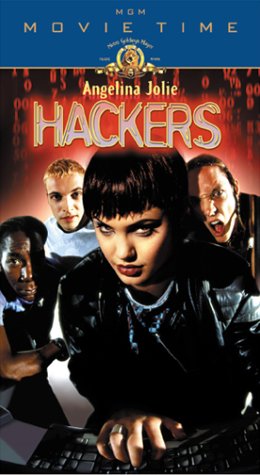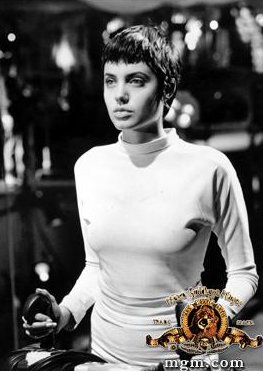

© 2006 William Ahearn
There is one good thing about this movie: Angelina Jolie in her first
starring role. She may be a total babe (and a good actress) but at least she’s
not a victim. It also has a multiracial cast since it concerns students at
a specialized New York City High School. The rest of this mess is utterly
baffling if you don’t know anything about computers and completely incomprehensible
if you do.
What is really annoying is how the script touches on important events
in the development of the internet and then jumbles them up into a story that
doesn’t even make sense.
The story opens in a courtroom in 1988 when Dade Murphy,
also known as Zero Cool and then Crash Overdrive, is being sentenced for writing
a virus that crashed some 1500 computers. Since “Hackers” is targeted
to young computer users, Dade has to be a high school student in 1995. So,
the scriptwriters did some simple math and when they were done they came up
with the idea that Dade Murphy had to have written the virus when he was 11
years old.
No kidding: an 11-year-old with access to the internet writing
a computer virus in 1988 and then being charged as an adult for a computer
prank?
What the episode plays on actually happened in 1988 but it wasn’t
a virus, it was a worm and it wasn’t just any worm, it was the Morris
Worm. Robert Tappan Morris was a graduate student at Cornell when he created
the worm to find out how many computers were connected to the internet. His
intention – far from the malware cranked out by script kiddies –
was a cyber census. His program had a flaw that ended up clogging transmissions
and bringing the network down. Conspiracy theorists loved the fact that Morris’
father was the Chief Scientist for the National Security Agency and that Robert
grew up with computers, including – so the story goes – an original
World War II German Enigma machine. Morris was arrested and was the first
person charged under the Computer Fraud and Abuse Act and was fined and sentenced
to probation and community service. Far from growing up into a sinister outlaw,
Morris has had a successful computing career working for the likes of Yahoo.
One of the other allusions used in the film is Emmanuel Goldstein,
a name used by one of the teen hackers. Emmanuel Goldstein is also the pseudonym
of the editor of 2600 magazine, the “hacker’s quarterly”
and a consultant to the film. But the real (or more specifically, unreal)
Emmanuel Goldstein is the opposition leader to Big Brother in George Orwell’s
1984. These annoying kids aren’t a resistance to anything specific,
they’re just vandals. Old school geeks know that the concept of hacking
is a layered one and not easily understood by people who don’t know
and love computers and networks. The concept of “White Hat” and
“Black Hat” hackers is defined more by whom it is done for than
by what is done. Internet stalking is a crime unless of course the work is
done for the FBI and the target is a pedophile or a terrorist.
Instead of exploring that, “Hackers” sinks into a teens-with-a-mission techno exploitation flick.
The plot seems to involve a female executive
and a male IT geek at an oil company who are going to steal $25 million dollars
and create the world’s worst oil spill to cover it up. Or something
like that. The relationship between these two is as unbelievable as anything
else in this flick. As in “The Net,” almost all of the uses of
computers are inaccurate and inane. There’s some nice now vintage computer
gear such as the Plexiglas Macintosh Duo laptop but that’s about it.
And who can stop the evil conspiracy?
Why the l33t HaX0rs at the high school, that’s who. This film could
have been called “Gidget Goes Gadget” and shot as the first cyber
comedy but it probably wouldn’t have ended up as unintentionally funny
as this mess. The only hack here is the script.
Many thanks to Michael Day for the film.

